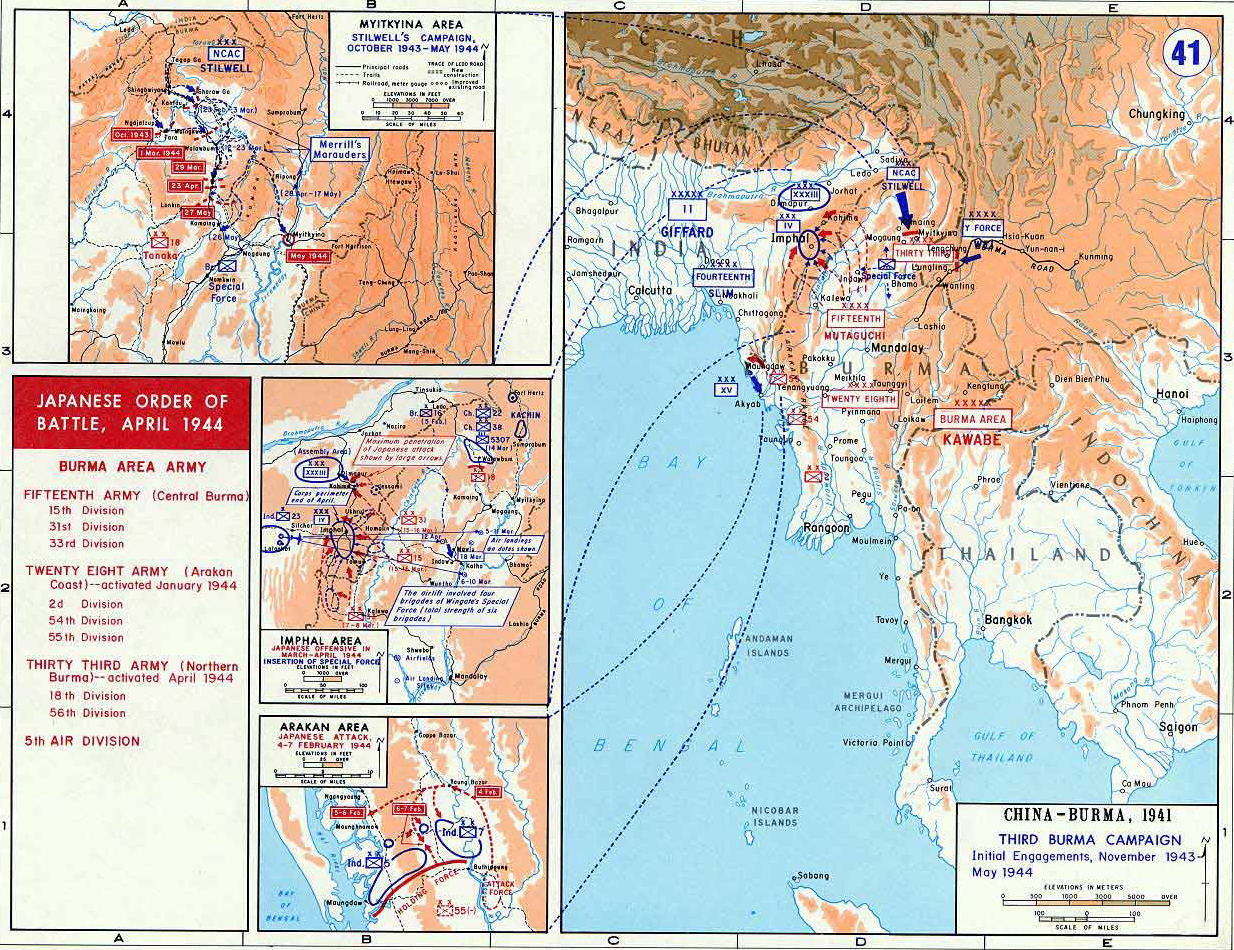Map Description
History Map of WWII: Burma Campaign 1943/44
The entire Burma Campaign was fought from 14 December 1941 - 13 September 1945, and was part of both World War II
and the Second Sino-Japanese War.
The campaign halted Japanese advances into India and set the stage for Allied counteroffensives in 1945. Additionally,
the campaign's complex interplay of conventional and irregular warfare demonstrated the Allies' adaptability while
exposing the Japanese Army's logistical overreach.
Illustrating:
Map ⓐ
Initial Engagements November 1943 - May 1944
Allied forces began preliminary operations aimed at disrupting Japanese supply lines and probing enemy defenses across
Burma.
In February 1944, the Chindits — under Major General Orde Wingate — launched their second long-range penetration
mission (Operation Thursday), establishing fortified bases behind Japanese lines and targeting key rail and communication
routes in support of Stilwell’s northern advance.
Meanwhile, Japanese forces were finalizing preparations for Operation
U-Go, their planned offensive into India via Imphal and Kohima.
Map ⓑ
Myitkyina Area
Stilwell's Campaign, October 1943 - May 1944
General Joseph Stilwell’s Sino-American forces, supported by Merrill’s Marauders (5307th Composite Unit), advanced
through the rugged terrain of northern Burma beginning in late 1943. Their objective was to capture Myitkyina, a
strategically vital airbase and transport hub on the route to China.
Despite severe logistical difficulties, disease,
and stiff Japanese resistance, Stilwell’s forces reached the outskirts of Myitkyina in May 1944 and laid siege to the
town.
After prolonged fighting, they captured it on August 3, 1944. The fall of Myitkyina marked a major Allied success
and enabled the eventual reopening of the Ledo-Burma Road, restoring a land supply route to China.
Map ⓒ
Imphal Area
Japanese Offensive in March - April 1944 Insertion of Special Force
The Japanese 15th Army, under General Mutaguchi Renya, launched Operation U-Go in March 1944, aiming to invade India by
seizing the key logistical centers of Imphal and Kohima. British and Commonwealth forces, encircled at Imphal, relied
heavily on aerial resupply to withstand the siege, while Special Force (the Chindits) disrupted Japanese supply lines
and rear-area operations.
The Japanese, suffering from overextended lines and critical shortages of food and ammunition,
failed to break Allied defenses. The eventual lifting of the siege in July marked a decisive turning point in the Burma
Campaign and the first major defeat of a Japanese army in open battle.
The fighting around Imphal and Kohima continued until July 1944.
Map ⓓ
Arakan Area
Japanese Attack, February 4-7, 1944
In the coastal Arakan region, the Japanese launched the Ha-Go offensive against British forces in early 1944, targeting
the 7th Indian Division under Major General Frank Messervy near the village of Sinzweya.
During the Battle of the
Admin Box (February 4–7), Japanese troops encircled Allied positions in an attempt to cut off and destroy them.
However, for the first time in the Burma Campaign, the surrounded units held firm and were resupplied entirely by air.
Coordinated artillery, air support, and determined infantry resistance repelled the Japanese assault. The victory
shattered the myth of Japanese invincibility in jungle warfare and demonstrated the growing effectiveness of Allied
coordination and logistics.
The name "Admin Box" by the way, comes from the fact that the battle centered around the defense of this administrative
"box" or perimeter, rather than a traditional front-line position.
Graph
Japanese Order of Battle, April 1944
-
Burma Area Army: Commanded by General Kawabe Masakazu.
- Fifteenth Army (Central Burma): Led by General Mutaguchi Renya, overseeing Imphal-Kohima operations.
- Twenty-Eighth Army (Arakan Coast): Activated January 1944 under General Sakurai Seizō.
- Thirty-Third Army (Northern Burma): Activated April 1944 under General Honda Masaki, tasked with countering Stilwell’s advances.
- 5th Air Division: Provided limited air support amid Allied air superiority.
Credits
Courtesy of the United States Military Academy Department of History.
Related Links
Map of the Burma Campaign: Slim's Offensive June 1944 - March 1945Map of the Burma Campaign: Allied Victory, April - May 1945
About World War II
WWII Timelines
About the Second Sino-Japanese War

